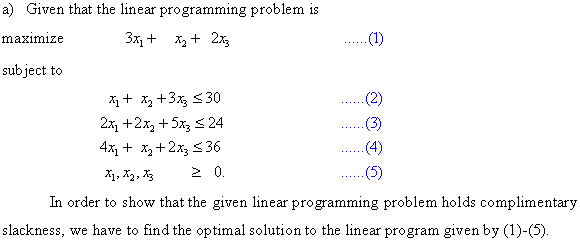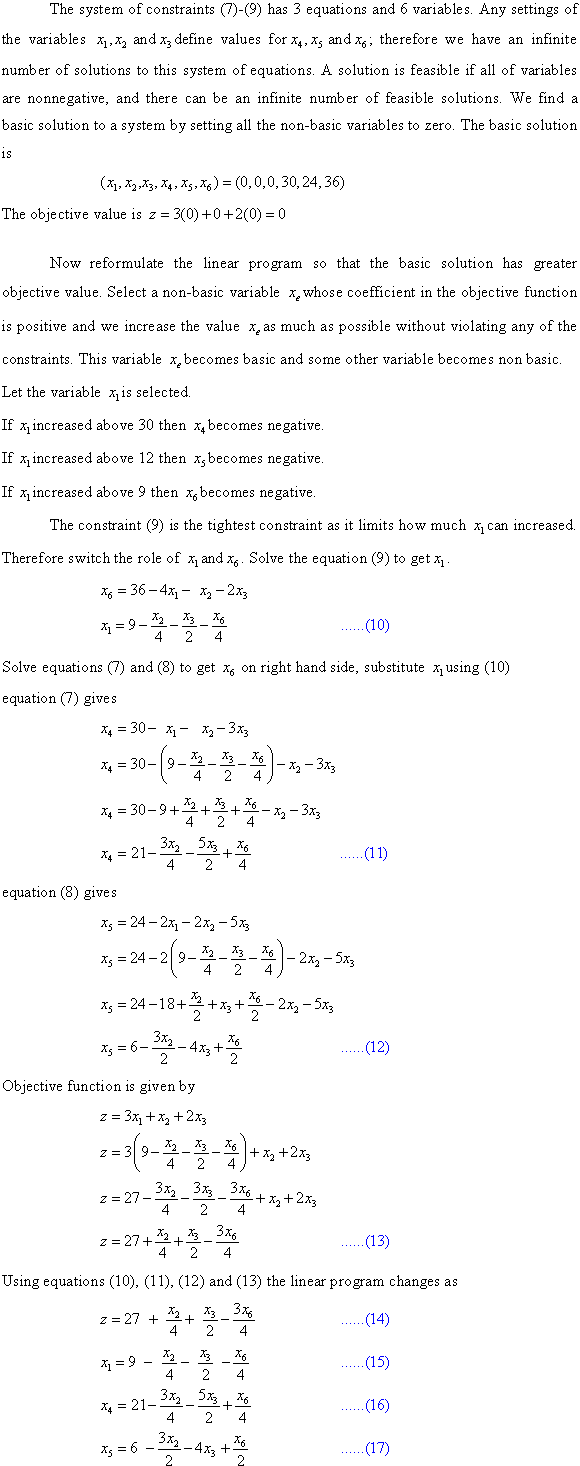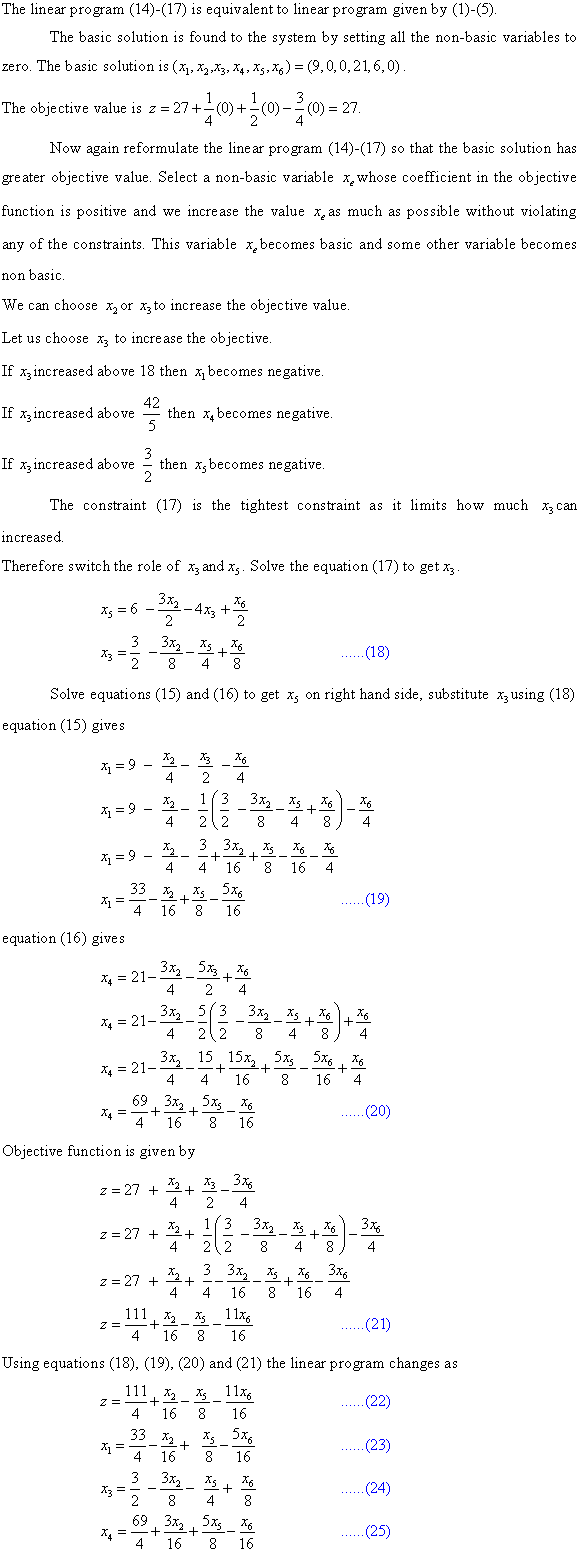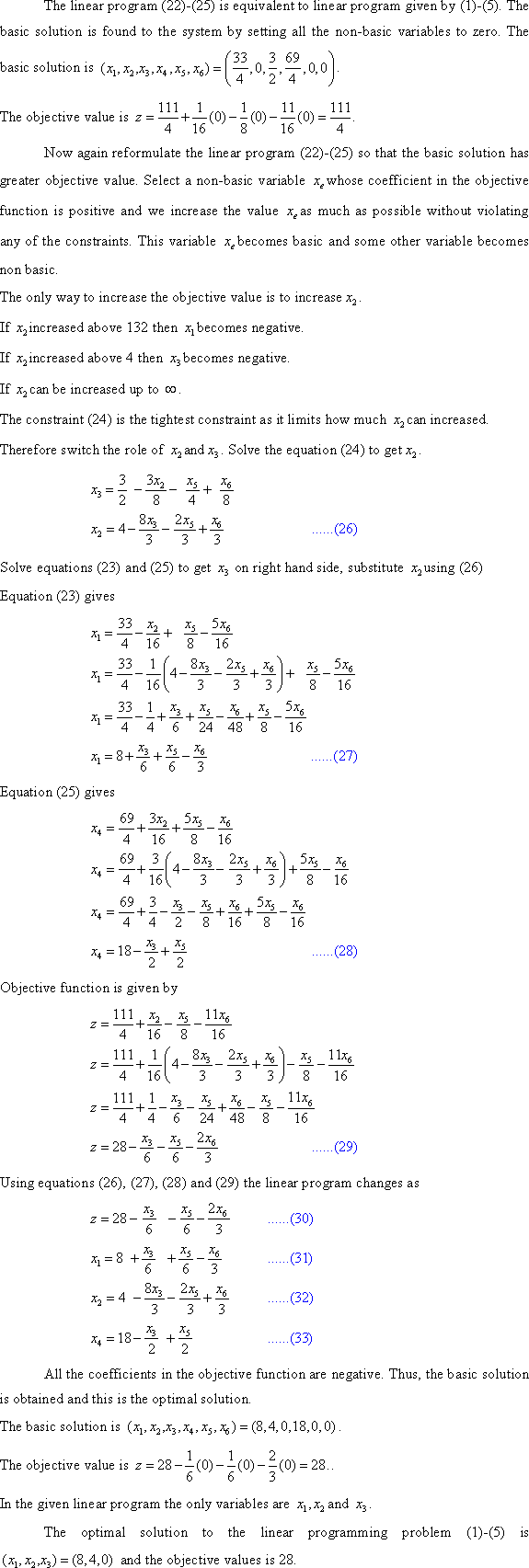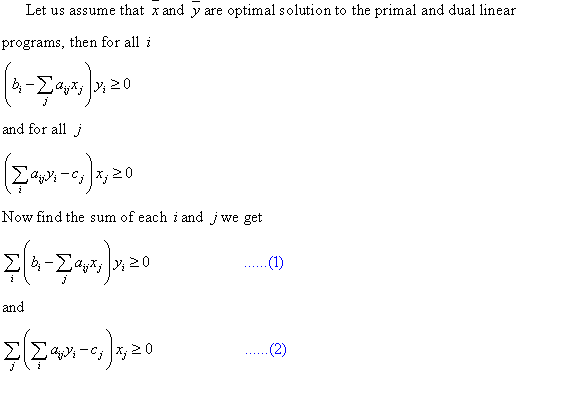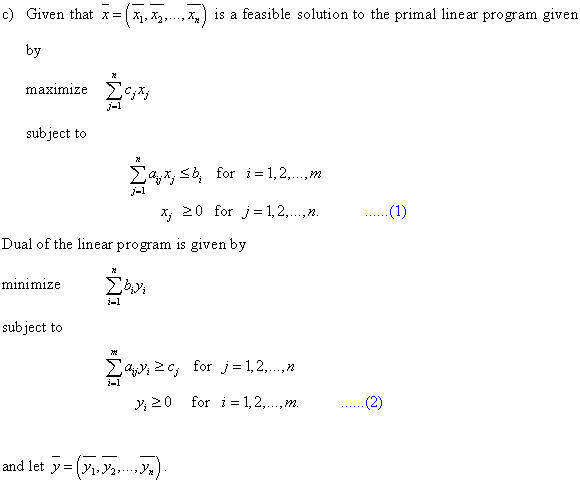a.
A linear program is generally a maximization or minimization problem and there can be either equations or the inequalities for the constraints.
Various algorithms are there for solving the linear programs, among them the most standard algorithm is the SIMPLEX algorithm. It generally has a fast running time. There is also algorithm whose running time is in polynomial, as ELLIPSOID algorithm. It is slower in practice.
Here to show that the algorithm for linear program can be used to solve the linear inequalities feasibility problem; consider the ELLIPSOID algorithm, it can be used to solve the feasibility problem. The notion is to have a big ellipse, that is the ellipse in the higher dimension. It must lie in the feasible region. Then we will test that the ellipse violates any constraint or not.
If there is no violation then the work is done. But if there is violation then look for it.
So in this way it is possible to know that the solution lies in the ellipse. And this step is repeated to create a smaller ellipse and so on. It has an advantage that you only have to show that the current solution violates the constraints or not.
So, if there is an algorithm for linear program, it can be used to solve the Linear Inequality Feasibility Problem.
b.
In this problem to show that there is an algorithm for linear inequality feasibility problem it is possible to use it to solve the linear program. For this, consider an example in which we have the inequalities procedure and on the basis of that the linear program is formulated,
Consider the example of maximum flow problem for this,
Network flow model: In which it is to be determined the maximum flow from the network.
Inequality constraints:
1. For the edge  set a
variable
set a
variable  and consider
only the positive flow in order to have the fewer constraints.
and consider
only the positive flow in order to have the fewer constraints.
Linear program:
Objective:
The objective is to find out the maximum possible flow through the edges of the flow network.
That is the objective function, given by:
Maximize:
 (The flow
into the t is maximized minus any flow out from the
t)
(The flow
into the t is maximized minus any flow out from the
t)
Constraints: (Below mention point 2. and 3. are constraints)
2. For all of the edges there is

(Capacity constraints)
3. For all of the vertices there is:

(Conservation constraints)
Integer Linear Programming
Linear Programming:
Linear programming is a way of achieving the maximum possible outcome from a set of resources that are represented as an integrated mathematical design.
In the technical terms, the linear programming is a way to achieve optimum results from the linear programming problems. This optimization is subject to a few constraints.
A linear program is commonly in the below given form:
In a standard form for a linear program, there is a set of
p real numbers that are , another
set of q real numbers that are
, another
set of q real numbers that are and a set
of
and a set
of real numbers
that are
real numbers
that are where,
where,


Now the objective is to find p real numbers such
that
such
that
Maximize:
 … … (1)
… … (1)
And that is subject to,
 … … (2)
… … (2)
 … … (3)
… … (3)
The first expression is called the objective function. The second and the third expression show the constraints.
Integer Programming:
This is just like a linear program with an extra rule. In this the variable are allowed to take only integer values. With this constraint, this programming is also known as the Mixed Integer Liner Programming (MILP). Many, but not all of the conditions that are true for the common linear programming, do hold for the Mixed Integer Linear Programming.
In the general form the integer program can be expressed as:
Minimize

Subject to condition,


 is
integer.
is
integer.
a.
Here, to show the weak duality for the integer linear program; as in the question, lemma (29.8) should be referred to.
The theorem defines that the objective function of any linear program that is in its primal form is always bounded for its upper limit by the objective function of its dual form. The value of the objective function for the primal form is always smaller than or equal to the value of the objective function for the dual form.
Considering the standard form of the linear programming there
are  real numbers
that are
real numbers
that are and the
m-real numbers
and the
m-real numbers  and
and
 -real
number
-real
number  for the
value of
for the
value of  and the
value of
and the
value of  and here
are to be found
and here
are to be found  real
numbers
real
numbers  with the
linear program as,
with the
linear program as,
(a) Primal linear program:
Maximize-
 … … (1)
… … (1)
Subject to condition-
 for
for … … (2)
… … (2)
 for
for … … (3)
… … (3)
Equation (1) represents the objective function for the integer programand the equation (2) and equation (3) represent the constraints for the objective function.
(b)Dual linear program:
When a dual linear program is referred then the original linear program is called as the primal. Dual for any linear program is just an image of the primal form of it. If the dual is found for a linear program that is already in the dual form, it yields the primal form of itself.
The dual form can be expressed mathematically as:
Minimize-
 … … (4)
… … (4)
Subject to condition-
 for
for … …
(5)
… …
(5)
 for
for … …
(6)
… …
(6)
In order to form the dual the maximizationis altered to minimization and the roles of coefficients on the right hand side and theobjective function are exchanged.
Now as considered in the required lemma here is which is a
feasible solution for the concerned primal linear program
(a) and
which is a
feasible solution for the concerned primal linear program
(a) and  be the
feasible solution for the dual of the same.
be the
feasible solution for the dual of the same.
Considering the above:
The relation can be obtained by using the inequalities of dual linear program (5)


Now, using the in the primal (2)

b.
It is to be shown that the duality does not always hold for the integer linear program. For the duality theorem refer to the section 29.4 of the textbook.
The simple statement representing the duality theorem is as below:
If there is an optimal solution for the primal form of the linear program and so does for the dual form of the linear program, then the values of the objective function of both of the primal program and dual form would be equal.
Considerthe issue:

They will form a weak dual pair if
 For all
For all
 and
and 
When the condition a=b is fulfilled there would be a strong dual pair. And the proposition that
 And the linear program
And the linear program
 Forms a pair of weak-dual problem So it shows that the weak duality
hold for the integer linear program but it is not true for the
strong duality. Hence the condition for duality in the integer
linear programming does not hold.
Forms a pair of weak-dual problem So it shows that the weak duality
hold for the integer linear program but it is not true for the
strong duality. Hence the condition for duality in the integer
linear programming does not hold.c.
In the given problem, there is an assumption that the both the primal integer and the dual integer program are both feasible and bounded. And various variables are used as:
1. P: - optimal objective value of primal of the linear program.
2. D: - optimal objective value of dual of the linear program.
3. IP: - optimal objective value of primal of the integer linear program.
4. ID: - optimal objective value of dual of the integer linear program.
In the previous sections both of the weak duality theorem and the strong duality theorems have already been proven. So, with reference to the theorem there holds the condition that:
1. As per the weak duality theorem of the linear programming the value of the objective function for the dual always dominates the value of the objective function of the primal form.
That is:
 .
.
2. According to the strong duality theorem solutions of primal form of the linear program and dual form of the same linear program are optimal only when their values are equal.
That is:
 ... … (1)
... … (1)
Here the solution is feasible so, the given relation is obtained by the using the above specified theorem
Using the weak duality theorem,
 … … (2)
… … (2)
Now as the integer programming takes only the integer values the optimal solutions for the integer solution would be less in amount. From here, the conclusion that the primal form of the linear programming would be greater than the primal form of the integer program and the dual for the linear program would be smaller than dual of the integer program.
 … … (3)
… … (3)
 … … (4)
… … (4)
Hence the following relation can be established by using all four of the above mentioned equations
 .
.
Proof of Farkas’ Lemma
Linear Programming:
Linear programming is a way of achieving the maximum possible outcome from a set of resources that are represented as an integrated mathematical design.
In technical terms, linear programming is a way to achieve optimum results from the linear programming problems. This optimization is subject to a few constraints.
Farkas’ lemma:
It is a fundamental tool useful for the proof of linear programming duality theorems. This is also known as the fundamental theory of linear inequalities. It is a mathematics result which says that a vector is either in a convex cone or a hyper plane, which exist to separate the vector from the cone. The illustration of Farkas’ lemma is as follows: Suppose there is a matrix A with dimensions and the
vector c that is an n-vector. In that case of a one
system, the form is
and the
vector c that is an n-vector. In that case of a one
system, the form is 
 And the
other is
And the
other is 
 Then only
one of them can have a feasible solution. It is not possible for
both of them to have a feasible solution at the same time. It is
considered as an example of a theorem of the alternatives. This
theorem states that among the two systems, one of them is the
solution. There will be no possibility of both of them or none, as
a solution. Farkas’ lemma has a wide range of applications in
linear programming. It is used in proving the problems related to
strong or weak duality theorem. It is also used as a basic game
theory.
Then only
one of them can have a feasible solution. It is not possible for
both of them to have a feasible solution at the same time. It is
considered as an example of a theorem of the alternatives. This
theorem states that among the two systems, one of them is the
solution. There will be no possibility of both of them or none, as
a solution. Farkas’ lemma has a wide range of applications in
linear programming. It is used in proving the problems related to
strong or weak duality theorem. It is also used as a basic game
theory.Proof:
According to the question it is to be proved that given A
which is a matrix and
the c is an n-vector. Then the Farkas’ lemma states
that, among two systems, exactly one of the systems can be
solved:
matrix and
the c is an n-vector. Then the Farkas’ lemma states
that, among two systems, exactly one of the systems can be
solved:

And

Where x is an n-vector and the y is an m-vector.
The two statements cannot hold simultaneously.
Consider that
 Such that
Such that
 And
And

Such that,
 And
And  then
then
 is a contradiction.
is a contradiction.
Consider that,

Then there is  such
that
such
that if and only
if
if and only
if
 .
.
From the theory of polyhedron and duality,
The representation of all convex polyhedral cones is given below:

For some matrix, it has been found out that for cones, the concept of polyhedral and finitely generated are equivalent as per the WEYL’s theorem.
The theorem says that:
A cone C is polyhedral if and only if it is finitely generated, that is, the cones are produced by a finite number of vectors.
Hence if and only
if
if and only
if  among the row of A such that
among the row of A such that  >0.
>0.
Clearly, as for each
column of A, so
for each
column of A, so
Hence, the required condition is fulfilled that is desired.
Minimum Cost Circulation
For a better understanding of a minimum cost circulation, knowledge of various terms used in it must be known such as network, circulation etc., to illustrate which, assume a network having a source and a link. The network consists of various nodes.
A flow network is nothing but a directed graph of vertices and edges. Each of the graph edge has a capacity. The capacity defines the data value that can be moved through that edge.
The capacity is always greater than 0. One more thing is that if there is an edge going from a vertex v1 to vertex v2 then no edge can go from v2 to v1.
A flow which is balanced at each node of the network is termed as a circulation. The cost of the circulation is identified with the cost of flow in the network. Minimum cost circulation is to be dealt with, here. It is a circulation which has the smallest possible cost in the network. In the network, there is no restriction on the network flow. Similar to the flow networks, minimum cost circulation problem must abide by the flow and capacity constraint for the network.a . Consider a graph G (V,
E); in this, V represents the set of vertices and
E represents the set of edges. Assume  the cost of
each edge
the cost of
each edge  which
denotes the cost of transportation of one unit along the edge in
the graph.
which
denotes the cost of transportation of one unit along the edge in
the graph.
Let  and
and
 be
the lower and the upper bound capacity of the flow of the network
along the edge
be
the lower and the upper bound capacity of the flow of the network
along the edge  and let
s (u) be the supply of the node u and
and let
s (u) be the supply of the node u and
 indicates the units of flow which are sent over the edge
indicates the units of flow which are sent over the edge .
.
The linear program is as:
Minimize-
 … … (1)
… … (1)
Subject to condition-
 for all
for all  … …
(2)
… …
(2)
 for all
for all  … …
(3)
… …
(3)
Where,
 … … (4)
… … (4)
 and cost
(u, v)>0. An optimal solution for this
minimum-cost circulation is to be found. Consider a circulation
C in the network which is not optimal and let C# be a
circulation which is optimal in the network G. For a given
circulation to be optimal it is to be shown that
and cost
(u, v)>0. An optimal solution for this
minimum-cost circulation is to be found. Consider a circulation
C in the network which is not optimal and let C# be a
circulation which is optimal in the network G. For a given
circulation to be optimal it is to be shown that  has a
negative cost cycle and the difference between C and
has a
negative cost cycle and the difference between C and
 that is
that is
 ;
termed as circulation. Thus, it has cycle decomposition; and since
the cost of C# is tinier than the cost of C, so the
difference, that is
;
termed as circulation. Thus, it has cycle decomposition; and since
the cost of C# is tinier than the cost of C, so the
difference, that is , is a
circulation with negative cost, and it is also viable in
, is a
circulation with negative cost, and it is also viable in . And it
shows that in the decomposition, at least one of the cycles has to
be negative. So the
. And it
shows that in the decomposition, at least one of the cycles has to
be negative. So the  contains a
negative cycle. Hence, the condition for having an optimal solution
is fulfilled.
contains a
negative cycle. Hence, the condition for having an optimal solution
is fulfilled.c. To find the Maximum Flow Problem as Minimum cost circulation:
A graph  is given in
which the V represents the set of vertices and E
represents the set of edges. It is also given that the source
s and the sink t and the cost c in the network
G.
is given in
which the V represents the set of vertices and E
represents the set of edges. It is also given that the source
s and the sink t and the cost c in the network
G.
So an edge  can be
summed up to the graph.
can be
summed up to the graph.
Now define the cost of the edges in the maximum-flow problem to

That is in turn equal to:

The capacities on the edge  are such
that
are such
that .It implies
that the direction of flow is from t to s.
.It implies
that the direction of flow is from t to s.
So there is one-to-one correspondence between the circulations
in the new graph and the flow in the original graph G. This
correspondence satisfies all the flow conservation constraints
in .
.
The cost of the circulation in the new graph is equal to the minus the net flow from s or into the t in the original graph.
The formulated form would be as below:
Minimize,
 … … (5)
… … (5)
Subject to:
 For all
For all
 … … (6)
… … (6)
 For all
For all  … …
(7)
… …
(7)
Hence, the maximum flow problem in the original graph G is equivalent to the minimum cost circulation problem in the new graph.
Hence, a solution from a maximum-flow problem to the minimum-flow problem can be obtained.d. To find the Single Source Shortest Path Problem as Minimum Cost Circulation Problem:
Consider the graph G (V, E) where V represent the set of vertices and the E represents the set of edges. It is also evident that a source s and the destination t, and d is computed which is the weight of the shortest path from s to t. Here w is the weighted function such that w:
 .
.
Linear program:
1. A new variable  is
introduced for each vertex v that is, the weight of the
shortest path from the source s to vertex v.
is
introduced for each vertex v that is, the weight of the
shortest path from the source s to vertex v.
2. Minimize
 … … (8)
… … (8)
Subject to the conditions:
 For
all
For
all … … (9)
… … (9)
 … … (10)
… … (10)
So, the above formulates the single source shortest path problem as the minimum cost circulation problem.

